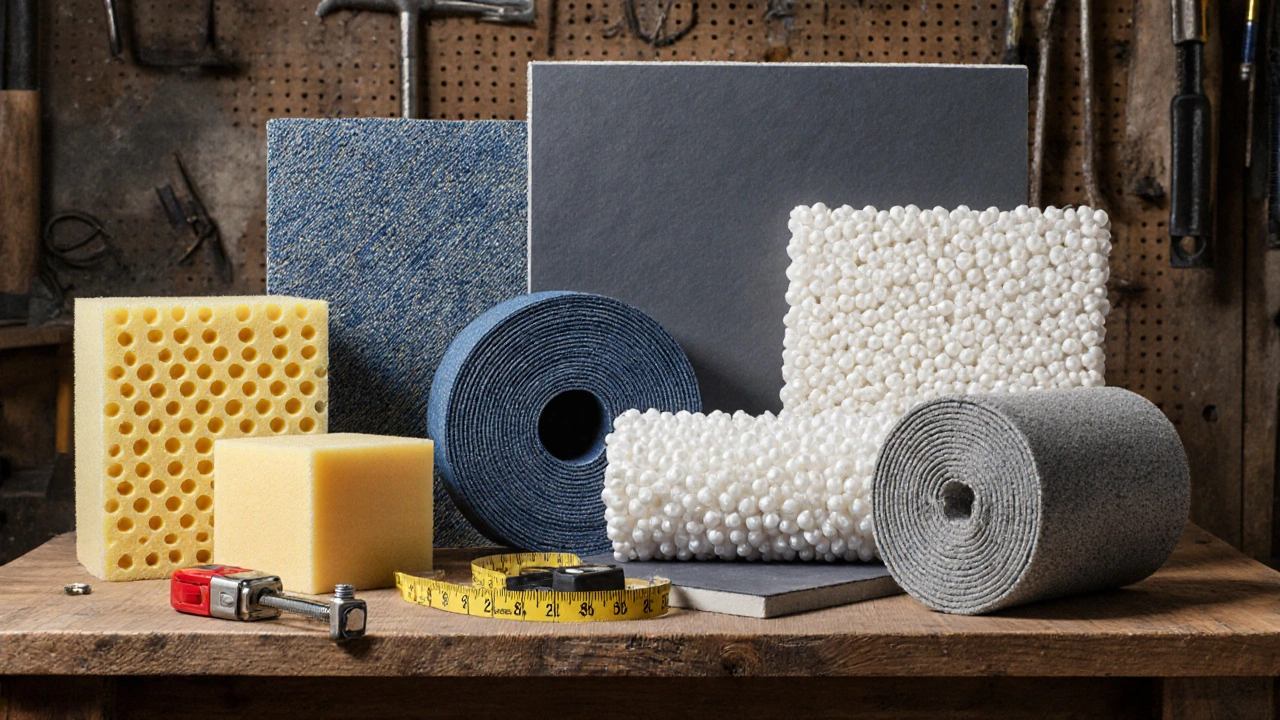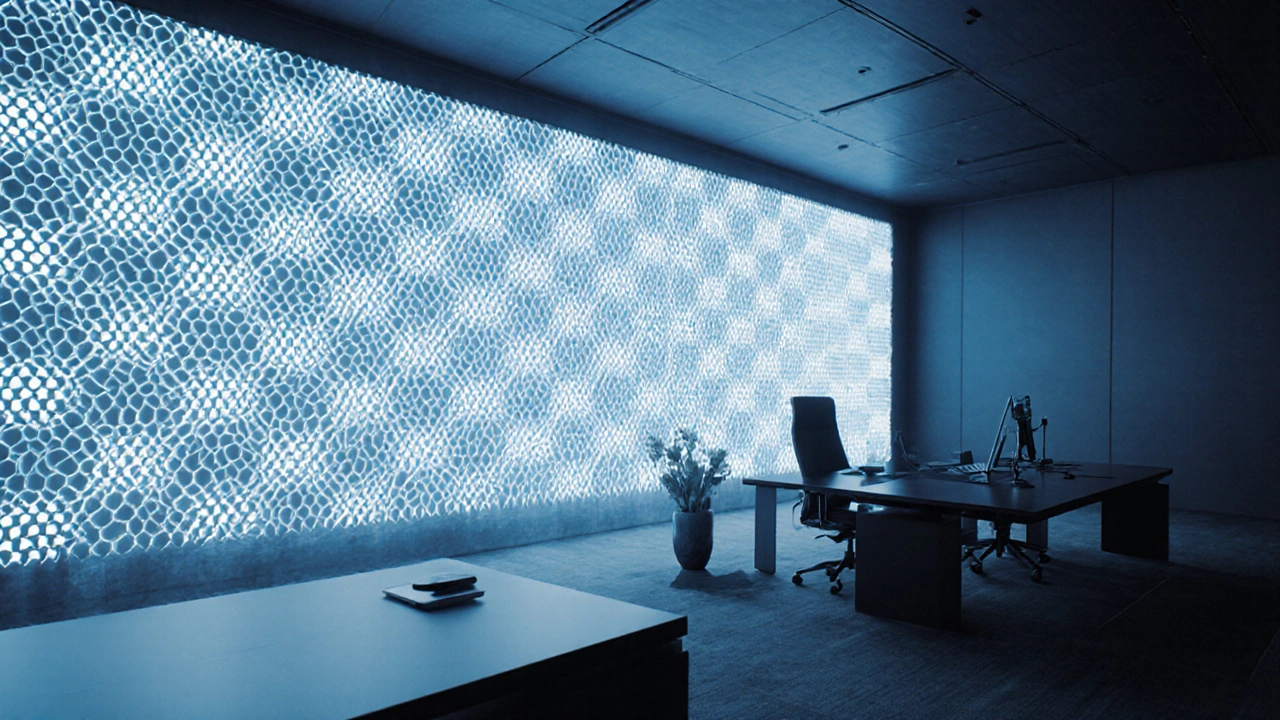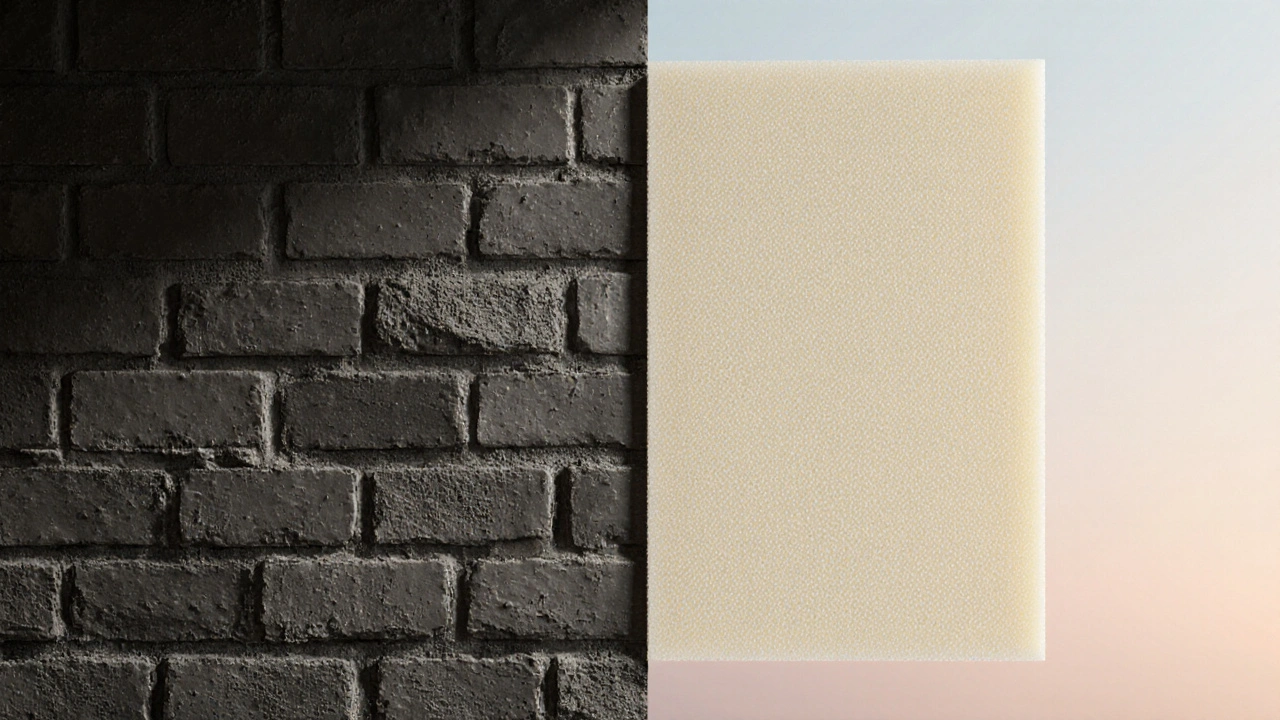Soundproofing Material Calculator
Soundproofing Material Calculator
When you think of soundproofing, heavy bricks and thick layers of dense board probably come to mind. But the market is shifting fast toward lightweight soundproofing materials that cut noise without piling on weight. These low‑density options deliver impressive acoustic performance while easing installation, trimming costs, and lowering the environmental footprint. Below you’ll discover why density matters, which products lead the pack, and how to pick the right solution for your space.
Why Low Density Can Mean High Performance
Lightweight soundproofing material is a type of acoustic insulation that uses cellular structures, porous fibers, or engineered composites to trap and dissipate sound waves while remaining lighter than conventional barriers. The key is how those tiny air pockets and flexible fibers interact with sound. When a sound wave hits a porous medium, part of its energy turns into heat through friction, and the rest is scattered in random directions. This process, called sound absorption, works efficiently even when the material’s mass per cubic meter is low.
Traditional wisdom says “more mass equals better sound blocking,” a principle captured by the Sound Transmission Class (STC) rating. While mass certainly helps, modern research shows that strategic geometry and material composition can achieve comparable STC scores with far less weight. Lower density also means thinner assemblies, making it feasible to retrofit historic buildings or retrofit apartments where space is at a premium.
Top Lightweight Options on the Market
Below are the most widely adopted low‑density products, each with its own strengths.
- Acoustic foam is a porous polyurethane or melamine foam with open‑cell structures that excel at mid‑high frequency absorption. Its typical density ranges from 20‑40kg/m³, making it easy to cut and mount.
- Recycled denim insulation uses post‑consumer denim fibers bonded with a low‑density binder. At about 30kg/m³, it offers natural sound absorption, fire resistance, and a sustainable life‑cycle profile.
- Expanded polystyrene (EPS) beads are fused into panels that deliver a blend of thermal insulation and acoustic damping. Densities as low as 15kg/m³ still provide decent NRC values when faced with airborne noise.
- Mass‑loaded vinyl (MLV) combines a thin, flexible vinyl sheet with a distributed load of mineral particles. Though called “lightweight” relative to concrete, its density sits around 80kg/m³-still lighter than solid walls while offering high STC scores.
- Acoustic panels made from high‑density fiberglass cores wrapped in fabric can be engineered to be thin yet effective, often weighing under 50kg/m³ per panel.
How Performance Is Measured
Two ratings dominate the acoustic world:
- Noise Reduction Coefficient (NRC) quantifies how much sound a material absorbs across a standard frequency range. Values run from 0 (no absorption) to 1 (complete absorption). Lightweight foams typically score 0.7‑0.9.
- Sound Transmission Class (STC) measures how well a barrier blocks airborne sound. While dense concrete walls might hit STC55+, engineered lightweight composites can reach STC45‑50 with less than half the mass.
When choosing a product, balance NRC (good for internal room acoustics) against STC (critical for separating rooms). A combination-like acoustic foam on a wall backed by a thin MLV layer-often delivers the best of both worlds.

Cost, Sustainability, and Installation Benefits
Lightweight materials win on three practical fronts:
- Reduced labor: Because they’re easy to handle, installers need fewer personnel and less equipment, cutting hourly rates by up to 30%.
- Material efficiency: Lower density means you can cover the same area with thinner boards, reducing overall volume and waste.
- Environmental impact: Many options-recycled denim, EPS, and certain foams-use post‑consumer feedstocks or have high recycled content. Their embodied carbon can be 40% lower than traditional gypsum board.
Initial material costs vary. Acoustic foam panels may run $2‑$4 per square foot, while recycled denim is priced similarly to standard fiberglass insulation. MLV, despite its higher density, is still cheaper per unit of STC than a full concrete wall.
Comparison Table: Lightweight vs. Traditional Soundproofing
| Attribute | Lightweight Options | Traditional Heavy Barriers |
|---|---|---|
| Typical Density (kg/m³) | 15‑80 | 200‑2400 (brick, concrete) |
| Average NRC | 0.6‑0.9 | 0.2‑0.4 (solid walls) |
| Typical STC | 40‑50 | 55‑65 |
| Installation Time (per 100sqft) | 0.5‑1day | 1‑2days (masonry) |
| Embodied Carbon (kg CO₂e/m³) | 30‑80 (recycled content) | 150‑300 (concrete) |
| Cost (USD per sqft) | $2‑$5 | $8‑$15 |
Choosing the Right Material for Your Project
Follow this quick decision flow:
- Identify the dominant noise source.
If you’re battling traffic or HVAC hum, prioritize high STC; for echo reduction in studios, focus on NRC. - Check structural limits.
Older buildings may not support heavy loads, making lightweight foams or denim a safe bet. - Set sustainability goals.
If a low carbon footprint is a must, look for recycled denim or bio‑based foams with at least 70% post‑consumer content. - Factor budget and timeline.
Acoustic foam offers the fastest turnaround, while MLV adds a modest weight for a big STC jump.
Often the best solution is a hybrid wall assembly: a thin layer of MLV for mass, topped with acoustic panels for surface absorption, and finished with a decorative fabric cover.

Common Pitfalls and How to Avoid Them
Even the smartest homeowner can trip up:
- Ignoring gaps: Sound travels through any opening. Seal edges with acoustic sealant or overlapping strips.
- Wrong orientation: Some foams have a directional pore structure. Install the “soft side” toward the noise source for optimal absorption.
- Over‑relying on NRC: A high NRC doesn’t guarantee privacy between rooms. Pair with a mass layer to improve STC.
- Skipping fire rating checks: Not all lightweight panels meet local fire codes. Verify compliance before purchase.
Future Trends: Smarter, Greener, Lighter
Researchers are blending nanocellulose fibers with recycled foam to create panels that are both ultra‑light (<10kg/m³) and boast STC55. 3‑D‑printed acoustic lattices are also entering the market, allowing custom shapes that fit irregular interiors without adding bulk.
As building codes tighten around embodied carbon, expect more incentives for using low‑density, high‑performance materials. Keeping an eye on certifications like Cradle‑to‑Cradle™ will help you choose products that audit well on both environmental and acoustic metrics.
Quick Checklist for Your Next Soundproofing Project
- Measure the space and note structural load limits.
- Define primary noise‑control goal (STC vs. NRC).
- Select a lightweight material that meets both acoustic rating and sustainability criteria.
- Plan for airtight seams and proper mounting hardware.
- Verify fire rating and local code compliance.
- Quote labor costs - lightweight often reduces installation time by half.
Frequently Asked Questions
Do lightweight soundproofing materials work for low‑frequency noise?
Low frequencies (below 125Hz) need mass to block effectively. While foam and denim excel at mid‑high frequencies, pairing a thin mass‑loaded vinyl layer or a dense rubber sheet with the lightweight material provides the needed inertia without a full heavy wall.
Are these materials safe for indoor air quality?
Most modern acoustic foams are made from open‑cell polyurethane with low VOC emissions. Recycled denim is naturally breathable and free of harmful chemicals. Always check the product’s indoor‑air‑quality certification (e.g., GREENGUARD) before installation.
How thick should a lightweight acoustic panel be?
For typical residential rooms, 2‑in‑inch fiberglass panels or 1‑in‑inch high‑density foam give an NRC of 0.7‑0.8. If you need higher STC, increase thickness to 3‑4inches or add a thin MLV sheet on the back.
Can I install these materials myself?
Yes, most lightweight products are DIY‑friendly. Acoustic foam and denim panels can be cut with a utility knife and attached with adhesive or mechanical fasteners. MLV may require a roller and sealing tape, but the process is still quicker than building a new brick wall.
What is the typical lifespan of these materials?
When installed correctly and kept away from moisture, lightweight acoustic products last 20‑30years. Recycled denim can even improve its sound‑absorbing capability over time as fibers settle.


Michelle Dela Merced
October 12, 2025 AT 18:32When I think about these feather‑light panels, I feel the future screaming at us! 🌟 The idea that you can slash weight while still smothering noise is pure alchemy. Imagine retrofitting a century‑old loft without the dread of sagging ceilings. This is the kind of innovation that makes my heart race.
Mark Conner
October 16, 2025 AT 05:52Look, nothing beats home‑grown American tech when it comes to acoustic performance. Our factories churn out foam and MLV that meet the toughest standards, and they do it without shipping carbon across oceans. If you want top‑notch soundproofing, keep it local and you’ll see the difference.
Charu Gupta
October 19, 2025 AT 17:12The article provides a thorough overview of low‑density acoustic solutions; however, certain quantitative claims could benefit from clearer sourcing. 😊 For instance, the embodied carbon figures for EPS panels seem optimistic compared to recent lifecycle assessments. A more rigorous citation would strengthen the argument.
Carl Boel
October 23, 2025 AT 04:32From a sustainability perspective, the embodied carbon metrics presented warrant a deeper dive; the omission of cradle‑to‑gate analysis obscures the true environmental impact. Moreover, the reliance on mineral‑laden MLV, while effective acoustically, introduces heavy metal considerations that contravene green building certifications. Stakeholders should therefore evaluate alternative bio‑based composites that balance density with ecological compliance.
Shuvam Roy
October 26, 2025 AT 15:52I’d like to emphasize the critical role of sealing all peripheral gaps during installation. Even a minute aperture can undermine the acoustic integrity of the entire assembly. Additionally, aligning the foam’s open‑cell orientation toward the noise source maximizes absorption efficiency.
Jane Grimm
October 30, 2025 AT 03:12While the exposition is commendable, the omission of fire‑rating standards for certain lightweight panels is a notable oversight. 🎓 In high‑rise constructions, compliance with NFPA 286 and ASTM E84 is non‑negotiable, and the article should explicitly address these regulatory benchmarks. Moreover, a brief comparison of smoke‑development indices would greatly aid practitioners.
Nora Russell
November 2, 2025 AT 14:32A critical appraisal reveals that the comparative table suffers from an inconsistent selection of performance metrics. The density range is presented, yet the accompanying thermal conductivity values are absent, which hampers holistic evaluation. Furthermore, the cost column lacks regional price variability, rendering the data less actionable for global audiences.
Craig Stephenson
November 6, 2025 AT 01:52Agreed, the table could benefit from a dedicated column for acoustic damping coefficients. Simple additions like that make the information far more usable for designers who need quick reference points.
Eve Perron
November 9, 2025 AT 13:12When dissecting the merits of lightweight soundproofing, it is essential to adopt a multidimensional framework that accounts for acoustic performance, structural compatibility, environmental stewardship, and economic feasibility; each of these pillars interlocks with the others, forming a cohesive decision‑making matrix that guides practitioners toward optimal solutions. First, the Noise Reduction Coefficient (NRC) provides a quantifiable measure of absorption across mid‑high frequencies, and materials such as open‑cell acoustic foam routinely achieve values between 0.7 and 0.9, thereby mitigating reverberation in studio environments. Second, the Sound Transmission Class (STC) evaluates the barrier’s ability to impede airborne sound, and while traditional masonry boasts STC values exceeding 55, engineered composites like Mass‑Loaded Vinyl can attain respectable STC scores in the 45‑50 range with substantially reduced mass. Third, the embodied carbon of each product, expressed in kilograms of CO₂ equivalent per cubic meter, reveals a stark contrast: recycled denim and EPS panels typically register between 30 and 50 kg CO₂e/m³, whereas conventional gypsum board may exceed 150 kg CO₂e/m³, underscoring the environmental advantage of low‑density alternatives. Fourth, installation logistics cannot be ignored; lightweight panels often require only a half‑day crew, dramatically cutting labor costs compared to the multi‑day processes associated with masonry or concrete. Fifth, fire safety remains paramount, and the fire‑rating classifications (e.g., Class A, B, C) must be verified for each material to ensure compliance with local building codes; many foam products now incorporate fire‑retardant additives to meet ASTM E84 standards. Sixth, acoustic sealing of joints and edges using acoustic caulk or overlapping tape prevents flanking transmission, a detail that can negate the performance gains of even the most sophisticated panels. Seventh, acoustic hybrid assemblies-combining a thin MLV layer with surface‑mount acoustic panels-deliver synergistic benefits, merging high STC mass with elevated NRC absorption. Eighth, cost considerations extend beyond material price; lifecycle cost analysis that incorporates maintenance, durability, and potential acoustic retrofits yields a more accurate financial picture. Ninth, the acoustic community increasingly emphasizes circular economy principles, advocating for recyclable or bio‑based materials that can be reclaimed at the end of their service life. Tenth, acoustic testing in situ, using calibrated microphones and octave band analysis, validates theoretical performance and uncovers unforeseen issues such as low‑frequency resonance. Eleventh, designers should remain vigilant about moisture resistance, as certain low‑density foams can degrade in humid environments, necessitating protective barriers. Twelfth, the acoustic environment also extends to indoor air quality, where off‑gassing of volatile organic compounds (VOCs) from some synthetic foams may pose health concerns. Thirteenth, the aesthetic versatility of fabric‑wrapped panels offers both acoustic and visual enhancement, allowing seamless integration into architectural themes. Fourteenth, acoustic consultants often recommend a tiered approach, starting with mass addition, followed by absorption, and concluding with diffusion for balanced acoustic treatment. Finally, the evolving research into nanocellulose‑reinforced composites promises future materials that surpass current benchmarks in both acoustic efficacy and sustainability, heralding a new era for lightweight soundproofing solutions.
Josephine Bonaparte
November 13, 2025 AT 00:32Great insight, thank you!
Meghan Cardwell
November 16, 2025 AT 11:52If you’re budgeting, consider that recycled denim insulation often matches standard fiberglass in cost while delivering a lower embodied carbon footprint; its natural fire resistance and acoustic absorption make it a compelling all‑round choice for residential retrofits.
stephen henson
November 19, 2025 AT 23:12The denim option truly shines when you factor in ease of installation and its “green‑cred” status 😊; plus, the material’s flexibility reduces cutting time, which can shave hours off the project schedule.
Rhys Black
November 23, 2025 AT 10:32One cannot simply gloss over the ethical implications of importing heavy acoustic panels from regions with lax labor standards; it is our civic duty to source responsibly, ensuring that the very silence we create does not come at the cost of another’s exploitation.
Abhishek A Mishra
November 26, 2025 AT 21:52Interestingly, recent studies reveal that nanocellulose‑reinforced foams can achieve comparable STC ratings while being sourced from sustainably managed forests, offering a path that aligns acoustic performance with ethical procurement.
Tom Lane
November 30, 2025 AT 09:12Evaluating the lifecycle cost of each material provides a fuller picture, revealing that upfront savings on cheap foam may be offset by higher replacement frequency and lower durability.
Darlene Young
December 3, 2025 AT 20:32The hybrid wall approach you mentioned is the gold standard; by coupling a thin layer of MLV with decorative acoustic panels, you secure both high STC blocking and vibrant NRC absorption without compromising interior aesthetics.
Roger Münger
December 7, 2025 AT 07:52Statistically, the NRC improvement per kilogram of added material plateaus beyond a density of 45 kg/m³, meaning that beyond this threshold, additional weight yields diminishing acoustic returns while inflating both cost and structural load.
Gerald Bangero
December 10, 2025 AT 19:12In the grand scheme, every decibel saved is a step toward quieter harmony, reminding us that thoughtful design not only protects our ears but also nurtures our collective well‑being.